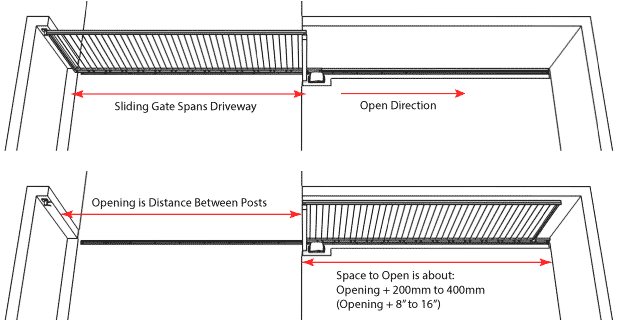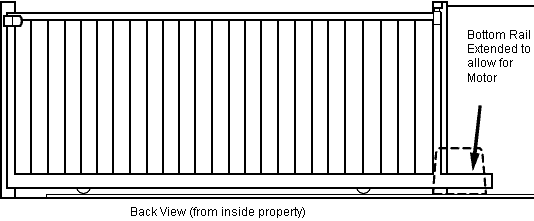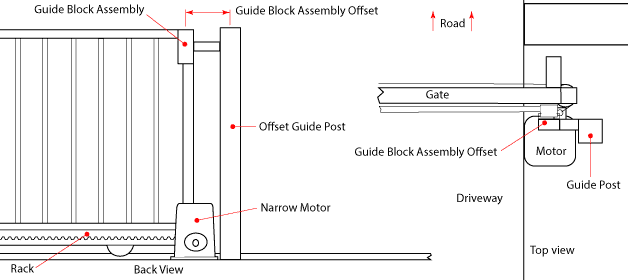
Space required for Automatic Sliding Gates?
Automatic Sliding Driveway Gates are a good choice because they can span wide driveways without taking up valuable driveway space and aren't affect by slope up from the road but do require side room to open, how much do they need?
Sliding or Rolling Gates can span a wide driveway but must have enough side room to open:


The motor (operator) is normally placed off the side of the driveway so its not in the way, which means the bottom rail must be extended to accommodate this. Typical extension is between 200mm (8") and 400mm (16") depending on the type and size of motor and other factors. The gate normally overlaps the fence posts or walls at each end making the gate a little wider, which is typically 50mm (2") at the closed end and 80mm (3 1/4") on the motor end but can be more or less depending on the layout of the fences, walls or posts and angle of the driveway.

Width of the gate = opening + close overlap + open overlap
Side room to open = width of gate + extension + stop.
The gate 'Opening' is the distance between any fences, walls or posts a gate slides behind or against.
The close overlap depends on whether the gate is closing behind or against a fence or wall. If opening behind the overlap is generally 50mm (2"), if opening against -10mm (-3/8") because the gate stops short.
The open overlap depends on whether a gate has a guide post or not. If not the overlap is generally 50mm (2") if there are guide rollers fitted to a metal post or 80mm (3 1/4") if guide rollers are fitted to a concrete or brick wall or a guide block and rail system is used.
READ MORE about Guide Systems for Sliding Gates

If you don't have room for the guide post but must use one then see Placing a Guide Post out of the way
Angled Driveways
If the driveway is angled towards the motor the open overlap will need to be increased so the guide post (if there is one) and motor are clear of the driveway.

If the driveway is angled away from the motor then the close overlap will need to be increased to keep the keeper clear of the driveway and the open overlap maybe less although will still need to be at least 50mm (2").

Finding the Extension
The amount of bottom rail extension for the motor depends on the motor used. The motor needs to either be aligned with the edge of the driveway or next to a guide post if there is one and the extension long enough to reach the output gear of the motor or the end of any strike plates or magnets required by the motor for its limit system.
READ MORE about Limit Systems for Gate Motors

A majority of sliding gate motors use limit switches to determine the open and close position of the gate and these require an extension of around 370mm (15") less the open overlap, which will be more if the gate is angled towards the driveway by how ever more the open overlap is.
If a motor has two magnets, one for the open limit and the second for close, allow what ever the width of the motor is less the open overlap for the extension.
Motors that have no Strike Plates or Magnets have nothing that takes up space on the end of the rack so need only enough extension to get past the output gear of the motor, which is around half the width of the motor + 60mm (2 3/8") less the open overlap.
You also need to allow space for a hard stop for the open position, which may add to the amount of space required for the gate to open.
If you don't have enough space for a Sliding Gate to Open
Two or three smaller sliding gates can be used to span a driveway, that stack one in front of the other, a little more than half or a third the width of the driveway space is required to open. These are commonly known as 'Telescopic" or "Stacker" Gates.

Two narrower sliding gates can also open apart from each other requiring a little more half the space of a single panel sliding gate per side, commonly known as a Bi-Parting or a Double Sliding Gate.
Finding the space required for each side to open is done in the same way as it is for a single panel sliding gate except the opening is halved and the overlap is 80mm (3 1/4") for the motor end and 10mm (3/8") between gates so totals 90mm (3 7/8") with the 10mm (3/8") being divided by two, although this can vary if the gate has guide posts or the driveway is at an angle as covered above.
Other alternatives when space is limited include: sliding gates on the outside of a wall or fence and sliding gates that go around a corner.
Side room Required for Telescopic Gates to Open
With telescopic gates the amount each gate 'travels' to open needs to be found first. The travel will be the same for each gate panel and is found with:
Travel = (opening + close overlap)/number of panels.
The opening and overlaps are the same as they are for a single panel sliding gate (see above).


The width of the front and any middle gate panels is the travel + overlap between gate panels. We use an overlap between panels of 80mm (3 3/16") because this is the width of the guide system and drive mechanism between the panels. The width of the back panel is travel + open overlap. The open overlap is the overlap between panels + 5mm (3/16") clearance + thickness of the gate to allow for a return if there is one.
Opening space for Telescopic Gate = width of back panel + extension + stop.
Finding the extension and stop is the same as that for single sliding gates so see above for details on this.
Gap Required Between a Fence and Guide Post for Telescopic Gates
Includes 'Front Clearance' the amount of space between the fence or wall and the front gate or cladding on this gate + 'Front gate Frame Thickness' inc. any cladding on the front of the gate + 'Frame Clearance' the gap between the gate panels (not including guide rails) + 'Back gate Frame Thickness' inc. any cladding on the front of the back gate + 'Back Clearance' the space between the back gate and its guide post or bracket (not including guide rails).

A suitable amount of 'Front Clearance' depends on what the fence or wall is made of and what any cladding is on the front of the panels. If its all stable material like concrete or metal then the clearance can be as little as 15mm. If its a material such as timber that can warp after the fact then the clearance must be larger to prevent any part of the gate coming in contact with the fence or wall, which could stop the gate from moving.
The 'Frame Clearance' depends on the size of the size and placement of the guide rail system, which depends on if there is any cladding fitted to the front of the frame or not. Guide rails are normally 25mm (1") thick and if the guide channel isn't cut into the frame then the 'Frame Clearance' is 75mm (3") so can have timber cladding up to 19mm (6/8") thick on the front of the frame. Any thicker than this and the guide channel can be packed out to allow more gap. If the guide channel is cut into the frame by 21mm (26/32") then the 'Frame Clearance' is 54mm (2 5/32") leaving 29mm (1 5/32") from the back of the guide rail to the front of the frame behind it, which is ideal if cladding is set into the middle of the frame.
The 'Back Clearance' is normally 75mm (3") if a 25mm (1") thick guide rail is used.
Total clearance for a two panel telescopic gate = Front Clearance + Frame Thickness x 2 + Frame Clearance + Back Clearance.
Total clearance for a three panel telescopic gate = Front Clearance + Frame Thickness x 3 + Frame Clearance x 2 + Back Clearance.
Placing a Guide Post out of the way.
The guide post normally goes hard up against the edge of the driveway. If space is limited, which it generally is for telescopic gates, then the motor must be hard up against the edge of the driveway to keep the amount of space for the gate to open to a minimum. In this case the guide post can be placed on the other side of the motor and have an arm reach over to where the guide block assembly needs to go. This also keeps the back of the motor clear so the user has access to the manual release. This can apply to single panel sliding gates too.

